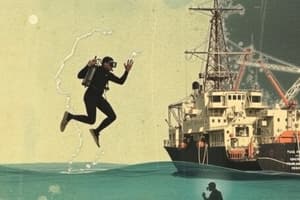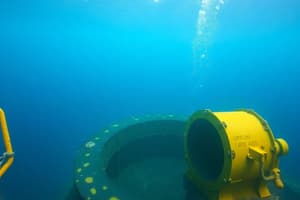Podcast
Questions and Answers
During the subsea spool tie-in operations, what primary factor led the Diving Supervisor to incorrectly assume the crane hook had reached the seabed?
During the subsea spool tie-in operations, what primary factor led the Diving Supervisor to incorrectly assume the crane hook had reached the seabed?
- The diver's report that the rigging was disconnected.
- Confirmation from the job hazard analysis (JHA).
- Visual confirmation from underwater cameras.
- The crane operator's report of 'no weight' on the crane wire. (correct)
What immediate action did the diver take after being struck by the crane hook?
What immediate action did the diver take after being struck by the crane hook?
- Administered self first aid for potential injuries.
- Remained in position to assess damage to the PHF.
- Initiated an emergency ascent to the surface.
- Reported being unharmed and returned to the dive bell. (correct)
Which of the following was identified as a direct cause of the crane hook striking the diver's helmet?
Which of the following was identified as a direct cause of the crane hook striking the diver's helmet?
- Failure to use the locating beacons properly.
- The diver exceeding the maximum depth limit.
- Inadequate length of the crane pennant/stinger. (correct)
- Sudden and unexpected change in weather conditions.
What specific recommendation was made to improve safety in similar subsea operations with poor visibility?
What specific recommendation was made to improve safety in similar subsea operations with poor visibility?
Besides specifying minimum pennant lengths, what additional procedural update was implemented by the member to prevent recurrence?
Besides specifying minimum pennant lengths, what additional procedural update was implemented by the member to prevent recurrence?
Flashcards
Subsea Incident
Subsea Incident
In subsea operations, a crane hook struck a diver's helmet during spool tie-in work due to misjudged position.
Causes of Crane Hook Incident
Causes of Crane Hook Incident
Inadequate crane pennant length and poor visibility hindered accurate positioning of the crane hook, leading to the incident.
Safe Distance
Safe Distance
Ensure adequate distance between divers and crane hooks using sufficient pennant length, especially in low visibility.
Enhanced Visibility
Enhanced Visibility
Signup and view all the flashcards
Reinforce communications
Reinforce communications
Signup and view all the flashcards
Study Notes
- During subsea spool tie-in operations, a diver's helmet was struck by a crane hook
What Happened
- Divers were working on the seabed in poor visibility during subsea spool tie-in operations
- After the pipe handling frame (PHF) landed, the Diving Supervisor told the crane operator to lower the crane hook to the seabed to disconnect rigging
- The crane operator reported 'no weight' on the crane wire, so the Diving Supervisor assumed the hook was on the seabed and told the diver to disconnect the PHF
- The crane hook unexpectedly struck the diver's helmet when the diver was positioned beneath the PHF disconnecting the rigging
- The diver was unharmed and safely returned to the dive bell, then the dive was aborted
- The diver's reclaim helmet was damaged beyond repair, including the side block, but the helmet's integrity was maintained
- The diver was unharmed
What Went Right
- Diver 2 helped Diver 1, ensuring that no injuries occurred
- Both divers returned to the bell safely immediately
- Both divers and the crane block had locating beacons for accurate tracking
- All procedures, lifting plans and Job Hazard Analysis (JHA's) were followed
- Protective equipment worked, because the diver was uninjured because the impact was absorbed by the helmet
What Went Wrong
- When the crane hook was lowered for PHF rigging disconnection, it rested on the top beam of the PHF, resulting in a 'no weight' reading and operator assumption the hook touched the seabed
- When the diver approached the disconnection point, the hook slipped off the beam and struck the side of the diver's helmet
Causes
- Inadequate crane pennant or stinger length failed to provide sufficient distance between the divers and the crane hook
- Poor visibility hindered the ability to accurately observe the crane hook
Lessons and Actions
- Ensure adequate distance between divers and crane hook by using a long enough crane pennant/stinger to maintain a safe distance
- Enhanced visibility aids and monitoring should be used such as additional locating beacons, underwater cameras, or sonar
- Reinforce communications, challenge assumptions to minimize assumptions regarding equipment position
- Clear communication and confirmation procedures between the dive supervisor, crane operator, and divers should be reinforced
- Member companies should update project procedures to specify minimum pennant lengths for different operations
- Conduct pre-operation inspections of all rigging and lifting equipment, including crane hooks and pennants, to ensure compliance
- Update the Job Hazard Analysis (JHA) to incorporate lessons learned from this incident regarding safe distances, visibility, and communication requirements for subsea lifting operations
Studying That Suits You
Use AI to generate personalized quizzes and flashcards to suit your learning preferences.




